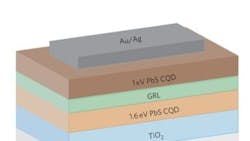Solar cells tap both visible, infrared range in one structure
Developers of a new solar cell say its structure could pave the way to inexpensive coatings that efficiently convert the sun’s rays to electricity.
In an article recently published by the journal Nature Photonics, University of Toronto researchers led by EE Professor Ted Sargent describe what they call the first efficient tandem solar cell based on colloidal quantum dots (CQD). The claim to fame of the device is that is a stack of two light-absorbing layers, one tuned to capture the sun’s visible rays, the other engineered to harvest the half of the sun’s power that lies in the infrared. Researchers managed this through use of a special interface between the visible and infrared junction. Sargent describes it as a cascade - really a waterfall - of nanometers-thick materials to shuttle electrons between the visible and infrared layers. the colloquial term for this is a graded recombination layer.
Tandem CQD solar cells can in principle reach up to 42% efficiency. The best single-junction solar cells hit a maximum of 31% efficiency.
Sargent is hopeful that in five years solar cells using the graded recombination layer will be integrated into building materials and mobile devices.
Sargent's work has garnered attention because it is amenable to being "painted on" surfaces. The solar cell materials are synthesized in solution which opens up the possibility of making a solution that consists of semiconductor particles dispersed in a solvent in a way analogous to ordinary paint.
Sargent says the application method is simply by coating a solid substrate with the solar cell material, letting the solvent dry and evaporate, which leaves a thin solid film. This all takes place at room temperature under ambient conditions, so the production process is potentially inexpensive, he says. Moreover, the underlying substrate can be flexible and inexpensive as well.
The Nature Photonics paper can be found here: http://www.nature.com/nphoton/journal/v5/n8/full/nphoton.2011.123.html#/access
Sargent took part in a YouTube video to explain the "painted-on" aspect of his work a bit more: http://www.youtube.com/watch?v=kLSARSw2JUQ
